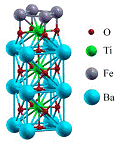Department of Physics and Astronomy: Publications and Other Research

Evgeny Tsymbal Publications
ORCID IDs
Tsymbal http://orcid.org/0000-0002-6728-5499
Document Type
Article
Date of this Version
2-2007
Citation
Progress in Materials Science (2006) 52(2-3): 401-420
doi: 10.1016/j.pmatsci.2006.10.009
Abstract
In the past few years the phenomenon of spin dependent tunneling (SDT) in magnetic tunnel junctions (MTJs) has aroused enormous interest and has developed into a vigorous field of research. The large tunneling magnetoresistance (TMR) observed in MTJs garnered much attention due to possible application in random access memories and magnetic field sensors. This led to a number of fundamental questions regarding the phenomenon of SDT. One such question is the role of interfaces in MTJs and their effect on the spin polarization of the tunneling current and TMR. In this paper we consider different models which suggest that the spin polarization is primarily determined by the electronic and atomic structure of the ferromagnet/insulator interfaces rather than by their bulk properties. First, we consider a simple tight-binding model which demonstrates that the existence of interface states and their contribution to the tunneling current depend on the degree of hybridization between the orbitals on metal and insulator atoms. The decisive role of the interfaces is further supported by studies of spin-dependent tunneling within realistic first-principles models of Co/vacuum/Al, Co/Al2O3/Co, Fe/MgO/Fe, and Co/SrTiO3/Co MTJs. We find that variations in the atomic potentials and bonding strength near the interfaces have a profound effect resulting in the formation of interface resonant states, which dramatically affect the spin polarization and TMR. The strong sensitivity of the tunneling spin polarization and TMR to the interface atomic and electronic structure dramatically expands the possibilities for engineering optimal MTJ properties for device applications.


Comments
Copyright © 2007, Elsevier. Used by permission